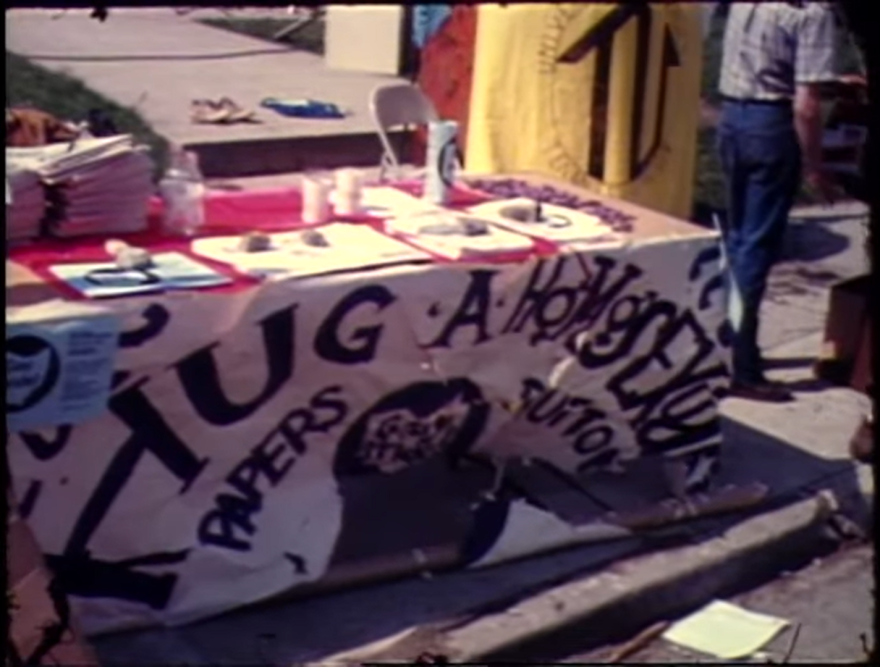After being derailed by the COVID-19 pandemic for two years, ComFest returned to Goodale Park to celebrate its 50th anniversary in 2022. This week, the all-volunteer-run festival will again welcome tens of thousands of visitors to hear live music, engage with community organizations, attend workshops, and shop with hundreds of vendors.
ComFest, which is short for a community festival, has grown dramatically since the first gathering in 1972.
Matthew DuPriest wrote to WOSU’s Curious Cbus to ask, “What are the origins of ComFest?”
Depending on who you ask, you may get a different answer on how the idea for a festival arose. But one thing we know for sure is that it was born around a nexus of activity at the corner of 16th and Waldeck Avenue, a block east of the Ohio State University campus.
The area was home to three campus faith organizations, the Ohio State Hillel, the United Christian Church, and the Wesley Foundation, which today is known as Summit on 16th United Methodist Church.
In the early 1970s, these buildings provided meeting space and offices for some of the groups collectively known as the Community Union. It included a food co-op, a crisis hotline, a tenants union, a free clinic, and the Columbus Free Press, then an underground anti-war newspaper.
All these organizations worked together with small business owners and neighborhood residents to get the first ComFest off the ground.

Aaron Leventhal was the director of the Hillel in 1972. He remembers approaching his colleagues Rev. Burt Cantrell and Rev. Norm “Pete” Snook about the idea of a festival located around the grass-covered median island that sat between their three buildings at 16th and Waldeck.
“I saw the possibility that that little grassy island could have a stage on it,” Leventhal said. “We'd have food vendors and we'd have arts and crafts and so forth, and they really liked the idea.”
From there Leventhal said he got the endorsement from the University Ministries Association and procured a permit from the city to block off the streets for a community festival.
According to members of the Community Union, the idea for a festival came from a desire to raise awareness about the work they were doing. A history published in the ComFest’s 2012 program guide stated that “By the beginning of 1972, a proposal to have a two-day block party to share and show off had drawn wide support.”

Mimi Morris was on the staff of the Columbus Free Press in 1972 and has volunteered with the festival from the very beginning. Though she eventually came around, she initially did not support the festival.
“I was one of, I think, six members of the staff of the Columbus Free Press who actually thought the first festival was a terrible idea because the United States was ramping up their attack on Vietnam,” Morris said. “And we thought it would be altogether the wrong time to stop and organize a party.”
In the years leading up to the festival, Ohio State University was a hotbed of student protests against the Vietnam war and racial injustice. In the spring of 1970, four students were killed by the National Guard at Kent State. Protests were escalating in Columbus including clashes between protesters, police, and guardsmen. The university administration decided to shut down the campus for two weeks to quiet demonstrations.
After that, tensions between student activists and the police remained high according to Jerry Friedman. He was the president of the OSU undergraduate student government during the 1971-72 school year and was active in the anti-war movement.
“We had a number of difficulties with the police force in terms of the way that they were treating students,“ Friedman said.
The week of the festival, Vice President Spiro Agnew was in Columbus for a Republican fundraiser when demonstrators allegedly threw something at his limousine, cracking a window. The FBI investigated and started questioning activists.

Friedman said that turned up the pressure. On May 11, demonstrators attempted to take over the campus ROTC building. Unable to do so, hundreds of protesters then moved east to High Street.
“There was some vandalism. There were some windows broken. There were some trash cans set on fire.” Friedman said. “And eventually the police came from 11th Avenue and Lane Avenue and kind of push people down 15th Avenue, basically using knee knockers and tear gas to disperse the crowd.”
This eventually led to dozens of arrests including several members of the Community Union.
The next day, a short distance from the previous night's unrest, volunteers began building the stage for music performances and bringing out tables for booths.
Morris remembers the festival as “wonderfully mellow” but admits that she was distracted.
“It was [a] nice day and good music and good spirits all around. And in the background, there's this whole other thread of worrying. Some of our friends were in jail and we needed to get them out,” Morris said.
OSU’s student newspaper, the Lantern, reported that festival vendors sold books, jewelry, candles and pottery. Local bands such as Trilogy, Bittersweet, and Cathexis performed throughout the day. About 30 different local organizations participated.

“Groups whose booths lined 16th Avenue included War Resisters League, Women's Liberation, and Girl Scouts. A sign on one exhibit read ‘Science for Vietnam,’ while another said ‘Hug a Homosexual,’” the paper reported.
Aaron Leventhal remembers the first community festival as an open free joyful event.
“It was just laid back, great vibes,” he said.
The University Ministries Association was only involved with ComFest for one more year. Community Union members and other volunteers continued organizing the festival at that location until 1983.
Do you have a question for Curious Cbus? Submit your idea below:





